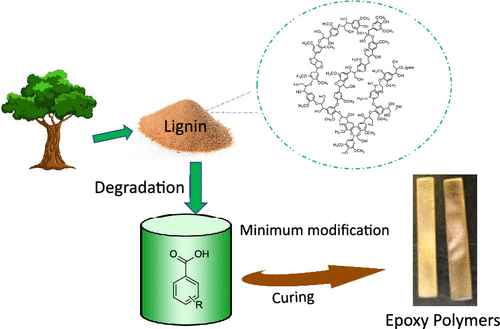当前位置:
X-MOL 学术
›
ACS Appl. Bio Mater.
›
论文详情
Our official English website, www.x-mol.net, welcomes your feedback! (Note: you will need to create a separate account there.)
Utilization of Lignin-Derived Small Molecules: Epoxy Polymers from Lignin Oxidation Products
ACS Applied Bio Materials ( IF 4.7 ) Pub Date : 2020-01-17 , DOI: 10.1021/acsabm.9b00954 Zhen Fang 1 , Matthew C Weisenberger 2 , Mark S Meier 1
ACS Applied Bio Materials ( IF 4.7 ) Pub Date : 2020-01-17 , DOI: 10.1021/acsabm.9b00954 Zhen Fang 1 , Matthew C Weisenberger 2 , Mark S Meier 1
Affiliation

|
Much effort has been invested in developing methods for producing small molecules from lignin as a way to source feedstock chemicals from renewable sources. Significant progress is being made, and methods for deconstructing lignin are producing good yields of small, mononuclear aromatic products—sufficient amounts to enable studies of the potential use of these compounds as replacements for compounds currently produced from petroleum. To investigate the use of lignin products in epoxies, we begin with aromatic acids that can be produced from lignin, treat them with epichlorohydrin to make glycidyl ethers, and investigate the thermal and mechanical properties of cured mixtures of these compounds with a commercial epoxy resin (EPON 826) and an anhydride curing agent (NMA). While most of the lignin-modified epoxy polymers exhibit good physical and thermal properties, the polymer prepared from p-hydroxybenzoic acid (compound 6) has a higher glass-transition temperature (Tg = 159 °C) than do thermosets made with other lignin-derived materials, such as vanillic acid diglycidyl ether (compound 4) and matches the Tg of cured samples of the commercial EPON-826/NMA epoxy system. This is significant, as p-hydroxybenzoic acid is readily available by simple hydrolysis of several different lignins and functions as a drop-in replacement for 50% of the BPA-based material in this commercial system without significant degradation of material properties. The use of lignin-derived small molecules in high-value systems such as epoxies may help improve the economics of biorefineries.
中文翻译:

木质素衍生小分子的利用:木质素氧化产物中的环氧树脂聚合物
已投入大量精力开发从木质素生产小分子的方法,以作为从可再生资源中获取原料化学品的一种方式。正在取得重大进展,解构木质素的方法正在产生良好的小型单核芳烃产品——其数量足以研究这些化合物作为目前从石油生产的化合物的替代品的潜在用途。为了研究木质素产品在环氧树脂中的应用,我们从可以由木质素生产的芳香酸开始,用环氧氯丙烷处理它们以制造缩水甘油醚,并研究这些化合物与商业环氧树脂的固化混合物的热和机械性能。 EPON 826) 和酸酐固化剂 (NMA)。对羟基苯甲酸(化合物6)的玻璃化转变温度(T g = 159 ° C)比用其他木质素衍生材料制成的热固性材料(如香草酸二缩水甘油醚(化合物4 ))更高,并且与商业 EPON-826/NMA 环氧树脂系统的固化样品。这很重要,因为p-羟基苯甲酸很容易通过几种不同木质素的简单水解获得,并在该商业系统中用作 50% 的 BPA 基材料的直接替代品,而不会显着降低材料性能。在环氧树脂等高价值系统中使用木质素衍生的小分子可能有助于提高生物精炼厂的经济性。
更新日期:2020-01-17
中文翻译:

木质素衍生小分子的利用:木质素氧化产物中的环氧树脂聚合物
已投入大量精力开发从木质素生产小分子的方法,以作为从可再生资源中获取原料化学品的一种方式。正在取得重大进展,解构木质素的方法正在产生良好的小型单核芳烃产品——其数量足以研究这些化合物作为目前从石油生产的化合物的替代品的潜在用途。为了研究木质素产品在环氧树脂中的应用,我们从可以由木质素生产的芳香酸开始,用环氧氯丙烷处理它们以制造缩水甘油醚,并研究这些化合物与商业环氧树脂的固化混合物的热和机械性能。 EPON 826) 和酸酐固化剂 (NMA)。对羟基苯甲酸(化合物6)的玻璃化转变温度(T g = 159 ° C)比用其他木质素衍生材料制成的热固性材料(如香草酸二缩水甘油醚(化合物4 ))更高,并且与商业 EPON-826/NMA 环氧树脂系统的固化样品。这很重要,因为p-羟基苯甲酸很容易通过几种不同木质素的简单水解获得,并在该商业系统中用作 50% 的 BPA 基材料的直接替代品,而不会显着降低材料性能。在环氧树脂等高价值系统中使用木质素衍生的小分子可能有助于提高生物精炼厂的经济性。


























 京公网安备 11010802027423号
京公网安备 11010802027423号